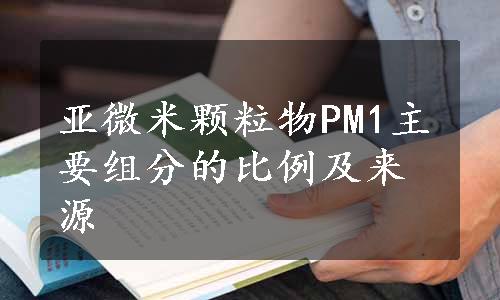
根据亚微米颗粒物PM 1中各种组分的理化特征及其对光学特性的影响,所有化学组分大体可分为以下4大类:水溶性无机离子(total water soluble inorganic ion,TWSII);有机物(organic matter,OM);矿物气溶胶(mineral);黑碳(BC)。其中的TWSII总浓度是实际测定的十多种无机离子浓度的总和,有机物浓度是实际测定的OC浓度乘上系数1.8,BC是实际测定的浓度。颗粒物中的矿物气溶胶浓度是根据实际测定的相关元素浓度,再根据公式[矿物气溶胶浓度]=2.2[Al]+2.49[Si]+1.63[Ca]+2.42[Fe]+1.94[Ti][27]估算而来,其中Si浓度是根据实际测定的Al浓度,再根据Si和Al在地壳中的比值(Si/Al=3.43)估算而来。图38-3显示了上述四大类组分在各个季节占大气气溶胶PM 1总质量的相对比值。

图38-3 PM 1中各组分在颗粒物中的比例(彩图见下载文件包,网址见14页脚注)
由图38-3可以清楚地看到,在4个季节,亚微米颗粒物PM 1中的TWSII和OM,合计占PM 1总质量的比例高达75%~80%,说明了人为污染源是亚微米颗粒物PM 1的最主要贡献者。颗粒物中的水溶性离子和OM,大都来自人为污染源。根据上述有关章节的讨论,上海PM 1主要来源于机动车排放与工业排放,而近年来机动车排放对上海亚微米颗粒物PM 1的贡献越来越大。矿物气溶胶在颗粒物中的比例在4个季度间变化不大。在沙尘暴活动较弱的年份,外来沙尘不是矿物气溶胶的主要来源,而扬尘,包括建筑扬尘、街道扬尘、机动车带起的扬尘,将原来沉降的矿物气溶胶再次带到大气中。这部分经过沉降再扬起的矿物气溶胶,比沙尘源区的沙尘气溶胶更多地富集在细颗粒物中。这也是为什么矿物气溶胶在上海雾霾及重度雾霾过程中的浓度也上升的原因。
综上所述,上海大气亚微米颗粒物PM 1,是上海颗粒物污染的核心贡献者,也是形成上海雾霾的占压倒比例的颗粒物粒径范围。换句话说,上海的大气污染问题,主要是细颗粒物乃至亚微米颗粒物PM 1的污染问题。OM和可溶性无机离子是上海大气亚微米颗粒物PM 1的最主要组分。二次无机离子SO 2-4、NO-3、NH+4(SNA)三离子及其形成的具高度吸湿性的化合物(NH 4)2 SO4和NH 4 NO 3,是上海大气亚微米颗粒物PM 1的最重要组分,在冬季NH 4 NO3比(NH 4)2 SO4浓度上升更快。船舶排放已经是上海大气不可忽视的污染源。
[1] Wang Y,Zhuang G S,Zhang X Y,et al.The ion chemistry,seasonal cycle,and sources of PM 2.5 and TSP aerosol in Shanghai.Atmospheric Environment,2006,40(16):2935-2952.
[2] Huang K,Zhuang G,Lin Y,et al.Impact of anthropogenic emission on air quality over a megacity-Revealed from an intensive atmospheric campaign during the Chinese Spring Festival.Atmos Chem Phys,2012,12(23):11631-11645.
[3] Huang K,Zhuang G,Lin Y,et al.How to improve the air quality over megacities in China:Pollution characterization and source analysis in Shanghai before,during,and after the 2010 World Expo.Atmos Chem Phys,2013,13(12):5927-5942.
[4] 张小曳,张养梅,曹国良.北京PM 1中的化学组成及其控制对策思考.应用气象学报,2012,23(3):257-264.
[5] 苏荣荣,钱枫,熊振华,等.北京市春季大气PM 1.0的微观形貌及富集特征//2013北京国际环境技术研讨会论文集.北京,2013:39-45.
[6] Xu J,Bergin M H,Yu X,et al.Measurement of aerosol chemical,physical and radiative properties in the Yangtze Delta region of China.Atmospheric Environment,2002,36(2):161-173.
[7] 邓雪娇,李菲,李源鸿,等.广州市近地层PM的垂直分布特征//第30届中国气象学会年会论文集.南京,2013:1-11.
[8] 邓雪娇,张芷言,李菲,等.广州地区PM1气溶胶、湿度效应与能见度的函数关系//第十一届全国气溶胶会议暨第十届海峡两岸气溶胶技术研讨会论文集.武汉,2013:118-128.
[9] Huang X F,He L Y,Hu M,et al.Characterization of submicron aerosols at a rural site in Pearl River Delta of China using an Aerodyne high-resolution aerosol mass spectrometer.Atmospheric Chemistry and Physics,2011,11(5):1865-1877.
[10] Cheng H,Gong W,Wang Z,et al.Ionic composition of submicron particles(PM 1.0)during the long-lasting haze period in January 2013 in Wuhan,Central China.Journal of Environmental Sciences-China,2014,26(4):810-817.
[11] 成海容,王祖武,张帆,等.武汉市大气霾期PM 1.0水溶性组分污染特征研究.第十一届全国气溶胶会议暨第十届海峡两岸气溶胶技术研讨会论文集.武汉.2013:45-48.
[12] 沈振兴,韩月梅,周娟,等.西安冬季大气亚微米颗粒物的化学特征及来源解析.西安交通大学学报,2008,42(11):1418-1423.
[13] 王浥尘,曹军骥,张宁宁,等.西安大气细颗粒(PM 1)化学组成及其对能见度的影响.地球科学与环境学报,2014,36(3):94-101.
[14] Shen Z,Cao J,Tong Z,et al.Chemical characteristics of submicron particles in winter in Xi'an.Aerosol and Air Quality Research,2009,9(1):80-93.
[15] Zhang Y J,Tang L L,Wang Z,et al.Insights into characteristics,sources,and evolution of submicron aerosols during harvest seasons in the Yangtze River Delta region,China.Atmos Chem Phys,2015,15(3):1331-1349.
[16] Sun Y,Jiang Q,Wang Z,et al.Investigation of the sources and evolution processes of severe haze pollution in Beijing in January 2013.Journal of Geophysical Research-Atmospheres,2014,119(7):4380-4398.
[17] Qiao T,Zhao M,Xiu G,et al.Seasonal variations of water soluble composition(WSOC,Hulis and WSIIs)in PM1 and its implications on haze pollution in urban Shanghai,China.Atmospheric Environment,2015,123:306-314.(www.xing528.com)
[18] 周敏,陈长虹,乔利平,等.2013年1月中国中东部大气重污染期间上海颗粒物的污染特征.环境科学学报,2013,33(11):3118-3126.
[19] 沈俊秀,肖珊,余琦,等.上海市道路环境PM 1、PM 2.5和PM 10污染水平.环境化学,2011,30(6):1206-1207.
[20] Shi Y,Chen J,Hu D,et al.Airborne submicron particulate(PM 1)pollution in Shanghai,China:Chemical variability,formation/dissociation of associated semi-volatile components and the impacts on visibility.Science of The Total Environment,2014,473:199-206.
[21] Huang X F,He L Y,Xue L,et al.Highly time-resolved chemical characterization of atmospheric fine particles during 2010 Shanghai World Expo.Atmos Chem Phys,2012,12(11):4897-4907.
[22] 顾卓良.霾天气不同粒径的颗粒物污染特征分析.环境监测管理与技术,2012,24(2):31-33.
[23] 陈慧娟,刘君峰,张静玉,等.广州市PM 2.5和PM 1.0质量浓度变化特征.环境科学与技术,2008,31(10):87-91.
[24] Lin J J,Lee L C.Characterization of the concentration and distribution of urban submicron(PM 1)aerosol particles.Atmospheric Environment,2004,38(3):469-475.
[25] Li J,Zhuang G S,Huang K,et al.Characteristics and sources of air-borne particulate in Urumqi,China,the upstream area of Asia dust.Atmospheric Environment,2008,42(4):776-787.
[26] Zhang D,Lee D J,Pan X.Potentially harmful metals and metalloids in urban street dusts of Urumqi City:Comparison with Taipei City.Journal of the Taiwan Institute of Chemical Engineers,2014,45(5):2447-2450.
[27] Malm W C,Sisler J F,Huffman D,et al.Spatial and seasonal trends in particle concentration and optical extinction in the United-States.Journal of Geophysical Research-Atmospheres,1994,99(D1):1347-1370.
[28] Werkenthin M,Kluge B,Wessolek G.Metals in European roadside soils and soil solution-A review.Environmental Pollution,2014,189(0):98-110.
[29] Zhao M,Zhang Y,Ma W,et al.Characteristics and ship traffic source identification of air pollutants in China's largest port.Atmospheric Environment,2013,64:277-286.
[30] Harrison R M,Tilling R,Romero M S C,et al.A study of trace metals and polycyclic aromatic hydrocarbons in the roadside environment.Atmospheric Environment,2003,37(17):2391-2402.
[31] Nagarajan R,Jonathan M P,Roy P D,et al.Enrichment pattern of leachable trace metals in roadside soils of Miri City,Eastern Malaysia.Environmental Earth Sciences,2014,72(6):1765-1773.
[32] Iqbal M Z,Sherwani A K,Shafiq M.Vegetation characteristics and trace metals(Cu,Zn and Pb)in soils along the super highways near Karachi,Pakistan.Studia Botanica Hungarica,1998,29:79-86.
[33] Smolders E,Degryse F.Fate and effect of zinc from tire debris in soil.Environmental Science&Technology,2002,36(17):3706-3710.
[34] Jones F,Bankiewicz D,Hupa M.Occurrence and sources of zinc in fuels.Fuel,2014,117:763-775.
【注释】
[1]“同步手工膜采样”表示人工使用滤膜采样器采样,并和气溶胶在线监测仪同步采样。也可称为“同步人工膜采样”。
[2]当量比定律亦称当量定律:当两种物质完全作用时,它们的克当量数相等。
[3]KMO(Kaiser-Meyer-Olkin)检验统计量是用于比较变量间简单相关系数和偏相关系数的指标,主要应用于多元统计的因子分析。KMO统计量是取值在0和1之间。当所有变量间的简单相关系数平方和远远大于偏相关系数平方和时,KMO值越接近于1,意味着变量间的相关性越强,原有变量越适合作因子分析;当所有变量间的简单相关系数平方和接近0时,KMO值越接近于0,意味着变量间的相关性越弱,原有变量越不适合作因子分析。
免责声明:以上内容源自网络,版权归原作者所有,如有侵犯您的原创版权请告知,我们将尽快删除相关内容。




